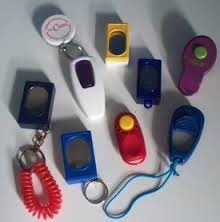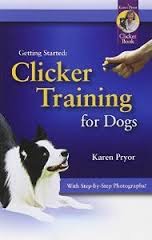Clicker training is a science-based way to communicate with your Cavalier. Its easier to learn than standard command-based training. You can clicker train any kind of a dog, of any age. Puppies love it! Old dogs learn new tricks. Not sure about husbands…
Don't worry, at first, about getting rid of behavior you don't like. Instead, start with some good things you want your Cavalier to do. Keep notes (the refrigerator door is a good place.) Jot down what the dog was doing when you started. Once a day or so, jot down what you have achieved with each behavior. You will be surprised at the progress! Reward yourself for your Cavalier's improvements. Here are some simple tips to get you started.
There are many types, shapes, sounds and brands of clickers. Find one that feels good in your hand and then buy a couple more just incase you misplace it like me! Personally, I like the ones with the popup button where I don't stick my thumb inside. I also like them with the wrist and have also been known to wear it around my neck. Do what is best for you!

Here are some simple tips to get you started. This is by Karen Pryor who I personally think is the guru in Clicker training and her books and programs for positive reinforcement is the best way for Cavaliers to learn. Cavaliers love to please and they thrive on clicker training.
1 Push and release the springy end of the clicker making a two toned click. Then treat. Keep the treats small. Use a delicious treat at first like little cups of roast chicken, steak --- not a lump of kibble.
2 Click DURING the desired behavior, not after it is completed. The timing of the click is crucial. Don't be dismayed if your pet stops the behavior when it hears the click. The click ends the behavior. Give the treat after that. The timing of the treat is not important.
3. Click when the dog does something you like. Choose something easy at first, that the dog is likely to do on its own. IDEAS: sit, come toward you, touch your hand with its nose, raise a paw, go through a door, or walk next to you.
4. Click once (in and out) if you want to express special enthusiasm, increase the number of treats, not the number of clicks.
5. Keep practice sessions short. Much more is learned in three sessions of 5 minutes each than in an hour of boring repetition. You can get noticeable results, and teach your dog many new things, by fitting a few clicks a day here and there in your normal routine.
6. Fix bad behavior by clicking good behavior. Click when the puppy relieves itself in the proper spot. Click for paws on the ground and not on the visitors. Instead of scolding for barking click for silence. Cure leash pulling by clicking and treating those moments when the leash happens to go slack. All positive reinforcement and this is the best way Cavaliers learn.
7. Click for voluntary (or accidental) movements toward your goal. You may coax or lure the dog into a movement or position, however don't push, pull, or hold it. Work without a leash. If you need a leash for safety's sake, loop the leash over your arm or thought your belt … don't use it as a tool.
8. Don't wait for the 'whole picture' or the perfect behavior. Click and treat for small movements in the right direction. You want the dog to sit, and it starts to crouch in the back: CLICK. You want it to come when called and it takes a few steps your way: CLICK!
9. Keep raising your goal. As soon as you have a good response - when the dog is voluntarily lying down, coming toward you, or sitting repeatedly - start asking for more. Wait a few beats, until the dog stays down a little longer, comes a little further, sits a little faster… THEN CLICK. This is called "shaping" a behavior.
10. When the dog has learned to do something for clicks, it will begin showing you the new behavior spontaneously, trying to get you to click. Now's the time to begin offering a cue, such as a word or a hand signal. Start clicking for that behavior if it happens during or after the cue. Start ignoring that behavior when the cue wasn't given.
11. Don't order the dog around: clicker training is not command based. If your dog does not respond to a cue, it is not disobeying it just has not yet learned the cue completely. Find more ways to cue it and click it for the desired behavior, in easier circumstances.
12. Carry a clicker and 'catch' cute behaviors like cocking the head or holding up a paw. You can click for many different behaviors whenever you happen to notice them, with out confusing your dog. If you have more than one dog, separate them for training and let them takes turns.
13. If you get mad, put the clicker away. NEVER train a dog when you are not in a good mood.
14 If you are not making progress with a particular behavior, you are probably clicking too late. Accurate timing is important. Get someone else to watch you, and perhaps to click for you a few times.
15. Above all, have fun!! Clicker training is a wonderful way to enrich your relationship with your dog.
Getting started Clicker Training for Dogs: click the book for a link to her website Karen Pryor Academy - KPA Dog training.
